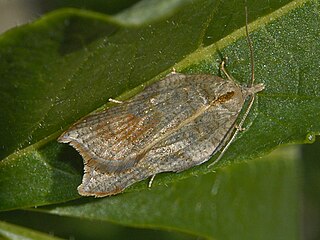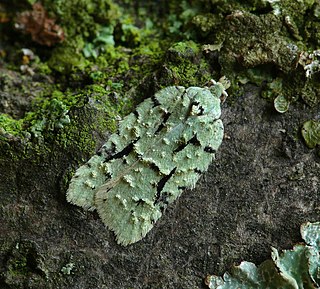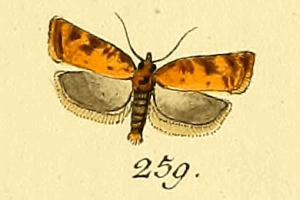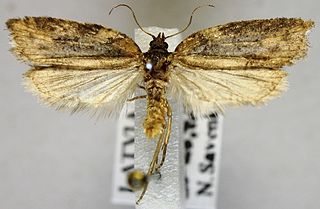Acleris sparsana is a moth of the family Tortricidae. It is found from western Europe to the Caucasus and Iran.

Acleris variegana, the garden rose tortricid moth or fruit tortricid, is a moth of the family Tortricidae. It has a Palearctic distribution. The moth flies from July to September mainly at night and is attracted to bright lights. The larvae feed on various trees and shrubs including rose and apple.

Acleris rhombana, the rhomboid tortrix, is a moth of the family Tortricidae. It is found in the Palearctic realm, from Europe to the Caucasus, Armenia, and Turkmenistan.

Acleris emargana, the notched-winged tortricid, is a moth of the family Tortricidae. The species was first described by Johan Christian Fabricius in 1775.

Acleris is a genus of moths belonging to the subfamily Tortricinae of the family Tortricidae. As of 2007, about 241 species were known.

Cnephasia is a genus of tortrix moths. It belongs to the subfamily Tortricinae and therein to the tribe Cnephasiini, of which it is the type genus.

Acleris hastiana is a moth of the family Tortricidae. It is found in Europe, northern Iran, Kazakhstan, Ala Tau, central Siberia, Irkutsk, the Amur region and China. In North America it is found from the north-eastern United States across southern Canada to British Columbia and south along the Pacific Coast to California.

Acleris literana, the sprinkled rough-wing, is a moth of the family Tortricidae. The species was first described by Carl Linnaeus in his 1758 10th edition of Systema Naturae. It is found in most of Europe and in the Near East.

Acleris maccana, the marbled dog's-tooth tortrix, is a moth of the family Tortricidae. The species was first described by Georg Friedrich Treitschke in 1835. It is found from Europe, east across the boreal regions to Siberia. In North America it occurs across much of the boreal forest region, south in the mountains in the east.

Acleris ferrugana is a species of moth of the family Tortricidae. It is found in China, most of Europe and has also been recorded from North America.

Acleris schalleriana, the viburnum button or Schaller's acleris moth, is a moth of the family Tortricidae. It was described by Carl Linnaeus in 1761. It is found in most of Europe. It is also found in North America. Acleris viburnana is a possible synonym that refers to the North American populations.

Acleris effractana, the hook-winged tortrix moth, is a moth of the family Tortricidae. It was described by Jacob Hübner in 1799. It has a Holarctic distribution. In Europe, it is found from northern Europe to the northern part of central Europe. It is also present in north-western Russia, Japan, Canada and the northwestern United States.
Acleris nigrilineana is a species of moth of the family Tortricidae. It is found in Korea, Japan, the Russian Far East and Denmark, Norway, Sweden, Finland, Poland, European Russia, Estonia and Latvia.
Acleris napaea is a species of moth of the family Tortricidae. It is found from Iran, Pakistan and Afghanistan eastward to Uzbekistan, Armenia and Turkmenistan. It is also found in Southeast Europe.

Acleris quercinana is a species of moth of the family Tortricidae. It was described by Zeller in 1849. It is found in most of Europe, Asia Minor and Iran.

Acleris lorquiniana, the marsh button, is a species of moth of the family Tortricidae. It is found in Iran and central and northern Europe, where it has been recorded from Great Britain, France, Belgium, the Netherlands, Germany, Denmark, Austria, Switzerland, the Czech Republic, Slovakia, Poland, Romania, Hungary, Sweden, Finland, the Baltic region and Russia. The habitat consists of damp fenland.

Acleris aspersana, the ginger button, is a species of moth of the family Tortricidae. It is found in Europe, where it has been recorded from Ireland, Great Britain, France, the Benelux, Germany, Denmark, Austria, Switzerland, Italy, the Czech Republic, Slovakia, Slovenia, Croatia, Hungary, Bulgaria, Romania, Poland, Norway, Sweden, Finland, the Baltic region and Russia. It is also found in the Near East and the eastern Palearctic realm. Their habitat consists of meadows and forest edges.

Acleris implexana is a species of moth of the family Tortricidae. It is found in Norway, Sweden, Finland, Russia and North America, where it has been recorded from Quebec to British Columbia and adjacent areas of the United States.

Acleris scabrana, the gray rough-wing moth, is a species of moth of the family Tortricidae. It is found in Europe, where it has been recorded from France, Belgium, the Netherlands, Germany, Austria, Switzerland, the Czech Republic, Slovakia, Poland, Hungary, Romania, Finland, Latvia, Lithuania, Ukraine and Russia. It is also found in Kazakhstan, Tian Shan, Yakutia, Asia Minor and North America, where it has been recorded from Alberta and British Columbia to California.

Acleris shepherdana, the meadow-sweet button, is a species of moth of the family Tortricidae. It is found in Europe, where it has been recorded from Great Britain, France, the Benelux, Germany, Denmark, Austria, Switzerland, Italy, the Czech Republic, Slovakia, Poland, Hungary, Norway, Sweden, Finland, the Baltic region and European Russia. It is also found in the Russian Far East (Ussuri), Manchuria, Mongolia, China and Japan. The habitat consists of fens, marshes, river-banks and other damp areas.















